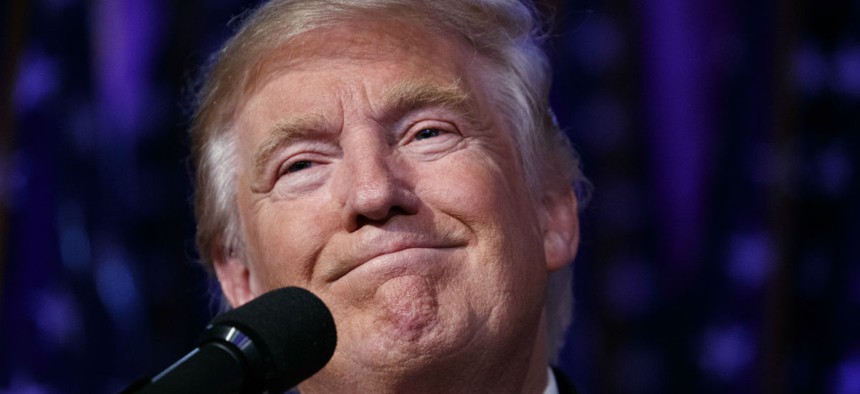
Matt Rourke/AP
How Trump’s Regulatory Agenda Could Transform Federal Agencies
Trump’s rollback of regulations would require a "big culture change," experts say.
Federal agencies could face a significant change in the scopes of their missions under reformed regulatory procedures proposed by President-elect Donald Trump, though he will first have to overcome the operational challenges involved in implementing his proposal.
Trump has said he will require agencies to eliminate two regulations for every new one issued, known in regulatory parlance as a “one in, two out” strategy. Former regulatory officials and experts in the field disagreed on exactly how Trump would put the policy in place, but agreed it would have a dramatic impact.
While Trump seemed to propose a literal approach, other nations that have implemented the policy have focused on the costs of rules. Susan Dudley, who served as administrator of the Office of Information and Regulatory Affairs under President George W. Bush, noted a "one in, one out" policy in Canada has referred to administrative costs, such as paperwork. In the United Kingdom, the Better Regulation Executive -- the country’s OIRA equivalent -- required its ministries and departments to offset compliance costs.
Jitinder Kohli, who served as the chief executive at the UK’s BRE from 2005 through 2009, when the country was first implementing its regulatory reduction procedures, said it would be difficult to “find anyone who thinks, taken literally, [that what Trump has proposed] is a sensible idea.” Agencies could implement a new, major regulation with a $1 billion annual compliance cost for businesses while eliminating relatively low-impact rules already on the books. Additionally, agencies may discover one element of a regulation is no longer effective and should be walked back, but the whole thing need not be repealed.
Kohli and Dudley said Trump would likely have the authority to implement his one in, two out policy by executive order. Amit Narang, a regulatory policy expert for Public Citizen, said Trump’s plan would instead require legislation.
“Even in the universe of anti-regulatory proposals this one would be ... radical,” Narang said.
Dudley said even if Trump delivers on his promise to implement the reform on his first day in office, the hard work would still lie ahead.
“Operationally it’s going to be complicated to put into place,” said Dudley, who is now the director at The George Washington University’s Regulatory Studies Center.
Those difficulties will take many forms; first, both the Bush and Obama administrations have already completed retrospective reviews that attempted to eliminate or streamline high-impact, unnecessarily burdensome regulations. The “low-hanging fruit,” Narang said, has already been picked.
“And the previous administrations did not find it easy,” Dudley added.
The Trump administration could also run into pushback from multiple avenues. Consumer groups such as Narang’s Public Citizen have warned Trump risks endangering the public by requiring a rollback of rules meant to protect Americans. Businesses may actually want to keep certain regulations on the books that have required them to make capital investments, as a repeal would give their competitors an advantage. Agencies themselves could also find it difficult to eliminate rules their employees think help carry out their missions, and they could decline to implement the regulations the Trump administration actually wants as leverage to protect those already on the books.
Young agencies, such as the Consumer Financial Protection Bureau, Narang said, may be hard pressed to identify enough regulations to unwind, as they simply have not issued that many. The Environmental Protection Agency, as it releases a long-anticipated regulation on lead in drinking water, could be forced to roll back its existing rules on the subject.
Kohli, now a managing director at Deloitte, said his success in the UK stemmed from building a consensus that involved various business groups, unions and consumer watchdogs. The UK government was able to focus on ways to streamline rules and make them work better to reduce compliance costs in ways that did not endanger the country’s citizens, he said. The ministries did not see major cutbacks on their workforces, he explained, but there was a “very big culture change.”
“The reality was the nature of their work changed significantly,” Kohli said.
Federal agencies will have to figure out to meet their statutory requirements while scaling back their regulatory reach, Dudley said. A positive impact of the policy, she said, is that it would give agencies incentives to focus on existing regulations, “what their impact is and how well they’re working.”
The current policy encourages agencies "really to think of the next regulation rather than to look back,” she said, adding the change could help agencies challenge their assumptions and calculations on cost-benefit analyses.
If agencies are forced to squeeze regulations into a certain cost framework, however, Narang argued it would “completely ignore the benefit side of the equation.”
“It’s a betrayal of cost-benefit analysis,” he said. “It’s basically just cost-cost analysis.”
Still, the approach has been successful in other countries. The UK has reduced its regulatory burden by about $10 billion since 2005, Kohli said. The choice between consumer protection and reducing costs was a “false dichotomy,” he added.
The Trump administration must still explain many details for its proposal, such as how long agencies will have to eliminate costs or individual regulations, if it will carve out certain departments, if it will provide for exceptions in emergency situations and how it will deal with the lengthy process for unwinding a federal regulation (undoing a regulation currently requires the same public notice and comment period as issuing a new one). Implementing the policy will ultimately require a buy-in from the employees across the federal workforce.
“There will be some people in agencies who will think it’s a great opportunity,” Dudley said, “but there will some resistance to it.”







